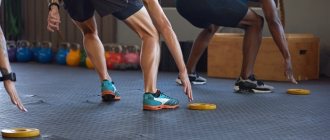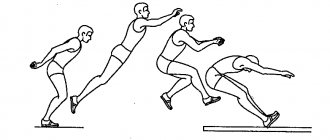Running 400 meters is a sprint distance in cross-country athletics. For such a long sprint, the athlete must have an excellent combination of power, speed and endurance, which is why this distance is especially revered among sprinters.
In this new article from a series of materials about running events, we will tell you everything about the 400-meter run - from A to Z.
Wade van Niekerk, current 400m world record holder
History of the discipline
This distance of 400 m is now unified throughout the world, but this was not always the case. Previously, in many countries, particularly the United States, athletes covered a distance of 402.336 m, which is equal to 440 yards or a quarter mile, while the traditional 400 m is 437.445 yards.
The Olympic history of 400 m dates back to 1896. It was then that this discipline appeared in the men's program of the Games. Women could not compete at such a distance until 1964.
If you look at the list of the best male 400m sprinters in the history of running, then without counting it becomes clear that the American school of running dominates here. But in the women's ranking, everything is not so clear: the glory is shared by representatives of Russia, the USA, the GDR and the Federal Republic of Germany (in the past).
Since 2020, the men's Olympic record is 43.03 seconds, and the women's is 48.25 since 1996. But in the first Olympics for four hundred meters, the results were much slower, especially among men. In 1896, American Thomas Burke won gold with a finishing time of 54.2 seconds.
Four years later, the men became faster: US runner Maxi Long set a new Olympic record in the first race - 50.4 s. And already in the final he improved his own record by a full second, running in 49.4 seconds.
Subscribe to “Marathon Man” on Telegram. Announcements of articles and useful selections every week.
The first Olympic women's 400m in 1964 was faster than the first men's in 1896. Betty Cuthbert, a sprinter from Australia, won gold, running in the final in 52 seconds, against the then world record of 51.9 seconds (1962).
For the first time, women broke the 50-second mark at the Games in 1976. The author of the new world record and the first Olympic one was the Polish athlete Irena Szewińska - 49.28 s (two years earlier she set the first world record of 50 s - 49.9).
Competition rules
In the summer season, the 400m race is held in a stadium of exactly the same length, so athletes only need to run one lap. In winter, they usually run two laps in a 200 m long arena.
At the stadium, each athlete moves and finishes on his own track, but indoors, after the first lap, all participants move to one track, so it is very important to win the first 200 m, which is why the first half of the distance is most often 1-2 seconds faster than the second.
The 400m race uses starting blocks to create a powerful burst at the start of the race. When the race is about to begin, the runner must stand in his starting blocks and wait for the gun to fire before starting to run.
A false start, that is, starting before the gun fires, means disqualification.
If there are a large number of participants, the competition is held in several rounds and includes preliminary heats, quarter-finals, semi-finals and, in fact, the finals.
This means that athletes must be prepared to run several 400m runs in one day without exhausting all their strength before the final race.
Van Niekerk sets a world record in the 400m at the 2016 Rio Olympics
An important point: even if before the final one of the participants showed a time better than that which would be victorious in the final, the winner is still determined by the results of the final, regardless of past results.
Recommendations
For the first 50 meters, the runner uses all the possibilities and accelerates at the highest speed. This way, the athlete will take more advantageous positions and avoid being blocked to the left edge. After this the pace slows down. Having picked up the pace, you need to maintain it and monitor the expenditure of energy, and maintain speed.
200 meters before the end of the distance the speed increases. 100 meters before the end of the distance the transition is calculated. In this area you need to give it your all.
Regular training and technical preparation will help you run successfully. Not only the physical fitness of the athlete is of great importance, but also the quality of his preparation, which he has achieved, observing all the requirements for middle-distance running. Otherwise, his success will be far from ideal.
If you find an error, please select a piece of text and press Ctrl+Enter.
400 meter running technique
How to run this long sprint race? Should you start slowly or go as fast as you can from the start? Here we will tell you about the stages of an ideal 400-meter race.
Although this is an endurance sprint, a quick start is very important. If a 400m runner starts the race too slowly, they will not be able to exploit the 6-7 second window in which lactic acid and hydrogen ions will not be produced.
This is approximately the first 50 m after leaving the starting blocks. During these few seconds, the runner moves at full speed with his head down and body bent, which helps achieve maximum speed.
In the next 50 m, the runner assumes a vertical position and returns to his race pace. You need to run straight, relaxing the upper shoulder girdle.
Keep the rhythm going for the next 100m, reaching the half distance mark. If you practiced running on a bend during the lessons, you should not experience a loss of speed when passing it.
The 200m mark in a 400m event should be achieved by an athlete approximately 1-2 seconds slower than their 200m best. For example, if a 400m runner is able to run 200m in 21.5 seconds, they should run the first 200m in the 400m run in 22.5–23.5 seconds.
Run fast but relaxed. In other words, roll on.
It is believed that the third 100 m is decisive in the race. As part of this phase of the race, you reach the second bend, at which you begin to pick up speed and engage in active arm work.
You need to do your best when there is just over 150 m left to the finish line. However, during this last push, the increase in pace will not be visually noticeable.
If there is a significant increase in speed, this indicates that the athlete ran the first 250 m too slowly and saved his energy in the last 100-150 m.
Finish – 100 m. This is where hell on earth begins, get ready to endure the pain. And the best way to get rid of it is to simply run faster. Relax your shoulders and jaws; there is no need to waste energy on tension.
Inexperienced athletes often slow down the last 2-5m before the finish, which wastes valuable time and can make a significant difference, as sprinting is all about split-second precision.
Women's 400m sprint at the 2019 Doha World Championships
How to run one kilometer
1000 m is a rather difficult distance, since it is fleeting and requires good speed training and endurance. To overcome it competently, it is important to follow some basic principles of training and running a race. Concentrate on cross-country training. To successfully cover a distance of one kilometer, you need an excellent supply of speed endurance.
Endurance comes only after tempo cross-country runs and hard training at the stadium. That is, you don’t just need to run 5, 7 or 10 km in 1 workout, but do accelerations of 300-500 m along the distance. There should be at least 5-7 of them. This is necessary so that the heart gets used to working at the limit of its strength.
It will also help you speed up during the competition distance. Incorporate sprint segments into your training process. In addition to endurance, you will need acceleration skills, which will essentially consist of a 1 km distance. Athletes don't wait very long in a run like this, so you need to be prepared for it.
Run around the stadium for at least 200m, 10-12 times at a good competitive pace. Always imagine that you are finishing. Then the speed will increase several times. Warm up well before the start. Already before the race, do a good warm-up. It should consist of light jogging (1-2 km), general warm-up and special running exercises.
Don't forget to also do some good long bursts of 60-100m. Put on comfortable shoes and get ready to start the race. Stick to a specific strategy. After the starting signal, do not immediately rush to lead the crowd of runners behind you, expecting to leave the start.
On the subject: Is it possible to sleep after running?
It is almost impossible to do this, since you will meet the wind, which will lead to very rapid fatigue. You should not rely on this step, even if you are confident in your abilities. Stay approximately in the middle, since it is also very difficult to attack from the very “tail”. After about 500-600 m, get close to the leading group.
It is advisable to start the finishing acceleration 200 m before the end of the race. Give it your all, and don’t let yourself be passed around in the inner radius. If you did everything right, you will have a great chance of winning.
- How I ran the daily run
- 1 km running standards
Some people's task is to run one kilometer
It just seems overwhelming.
Of course, how easy it will be for you to run depends on the degree of preparedness of your body. If you are faced with the task of running a kilometer
, make sure you are in shape by the time you start.
- Sneakers or sneakers, tracksuit
Create a workout schedule for yourself. Determine the days on which you want to exercise.
Start by walking. Just walk. Walk through the forest, park or city. Choose your own pace that is comfortable for you. Watch your breathing: breathe rhythmically, deeply, through your nose so that your muscles and internal organs receive enough oxygen. When you can walk for an hour without much effort, start running. Gradually introduce running into your training program.
Let it be 5 minutes at first, then 10, then twice for 10 minutes. Consider your strength, do not bring yourself to exhaustion. After running, warm up and stretch your muscles. After completing the warm-up, you can run a little more. Do a set of exercises for all muscle groups, but do not allow unexpected overload.
Lead a healthy lifestyle, get good sleep, stop drinking alcohol and tobacco, and eat right. It is necessary to consume a sufficient amount of protein food, because it is on its basis that muscles grow. And to have the strength to train, you need carbohydrates. In this case, cereals made from grains and cereals, potatoes, fruits and vegetables will be useful.
But it’s better not to get carried away with pasta and baked goods. When you feel like you’re ready to run a kilometer
without stopping, think about your start.
Imagine the distance, think about how you will behave at each stage. Mentally “run” this kilometer
. At the very beginning, it is better not to rush, but to choose a restrained and comfortable pace for yourself.
Important!
But closer to the finish line, you can allow yourself to accelerate. Before running a kilometer
, don’t forget to do a little warm-up (at least walking). Warm up your muscles, prepare them for running. Set yourself up correctly.
Tell yourself: “I am a strong-willed and strong person”, “I can easily run one kilometer
", "I'm ready to run
one kilometer
, I can handle it."
But don't get carried away with self-tuning too much. If you feel like you're not ready to walk a kilometer
, don't kid yourself. Be honest with yourself.
If you have any health problems, be sure to consult your doctor before starting training. Ask him what load is acceptable for you, what types of exercises should be avoided, find out general recommendations for you in planning the training process. Remember that the key to success is regularity of training. Issues with the placement of emphasis sometimes arise even in frequently used words. For example, listening to the speech of others, you can find that in the word “kilometer” the stress is placed either on “O” in the second syllable, or on “E” in the third. Which of these options corresponds to the norms of the Russian language?
Which syllable is stressed in the word “kilometer”?
In the word “kilometer” the stress must be placed on the third syllable - it falls on the vowel “E”. It is this literary norm that is indicated by all dictionaries of the Russian language, both explanatory and orthoepic, without exception.
Moreover, when changing the word “kilometer”, the stress will remain unchanged in all cases, both singular and plural:
- run a cross-country race for two kilometers,
- the distance from Nice to Paris in a straight line is 687 kilometres,
- One kilometer corresponds to 100 meters,
- zero kilometer is the starting point for measuring distances.
Placing the stress in the word “kilometer” on the second syllable (and this option can be heard quite often in speech, it is also found in poetry of the Soviet period) is considered a mistake, and a rather gross one at that.
Many believe that the emphasis “kilometres” refers to professionalism, but the authors of dictionaries do not consider it acceptable even in the speech of specialists.
For example, in Reznichenko’s orthoepic dictionary the accent “kilOmeter” is listed with the note “wrong!”, and in Gorbachevich’s dictionary of pronunciation difficulties it is listed with the comment “not recommended.”
Thus, in any speech situation, the only acceptable option for placing stress will be “kilometer”.
Why should the word “kilometer” be emphasized this way?
into Russian from the French language , along with the metric system developed by the French. And, like many borrowed words, the Russian word “kilometer” retained the same emphasis as kilomètre in the source language. And in French, as you know, the last syllable is always stressed.
Similarly, the last syllable is stressed in other measures of length adopted in the metric system (for example, centimeter, millimeter, gigameter, and so on).
The placement of stress in the word “kilometer” is subject to the logic of the Russian language. In words formed by adding stems or by adding “meaningful” prefixes, the stress in most cases is at the end of the word. For example:
- bureaucracy,
- monologue,
- overpass,
- ammeter.
The word “kilometer” is also subject to the same principle, the emphasis in which falls on the second part of the word, on the root “-meter”.
Source: https://www.kakprosto.ru/kak-95167-kak-bezhat-odin-kilometr
Shoes for 400m running
Sprinters run in spikes - special hard shoes with spikes on the sole. But, as usual, there should be different shoes for different disciplines. Because the 400m is a long sprint, the spikes are not the same as for 100m runners.
They have a thicker heel and a less rigid sole. In the 400m sprint, athletes run two turns, which also affects the structure of their shoes: they need more serious grip.
Here are some models that have proven to be the best:
- Nike Zoom 400
- adidas Finesse
- Nike Superfly Elite
- Nike Zoom JA
- Under Armor Speedform Sprint 2
- New Balance Vazee Verge V1
- Saucony Spitfire 5










